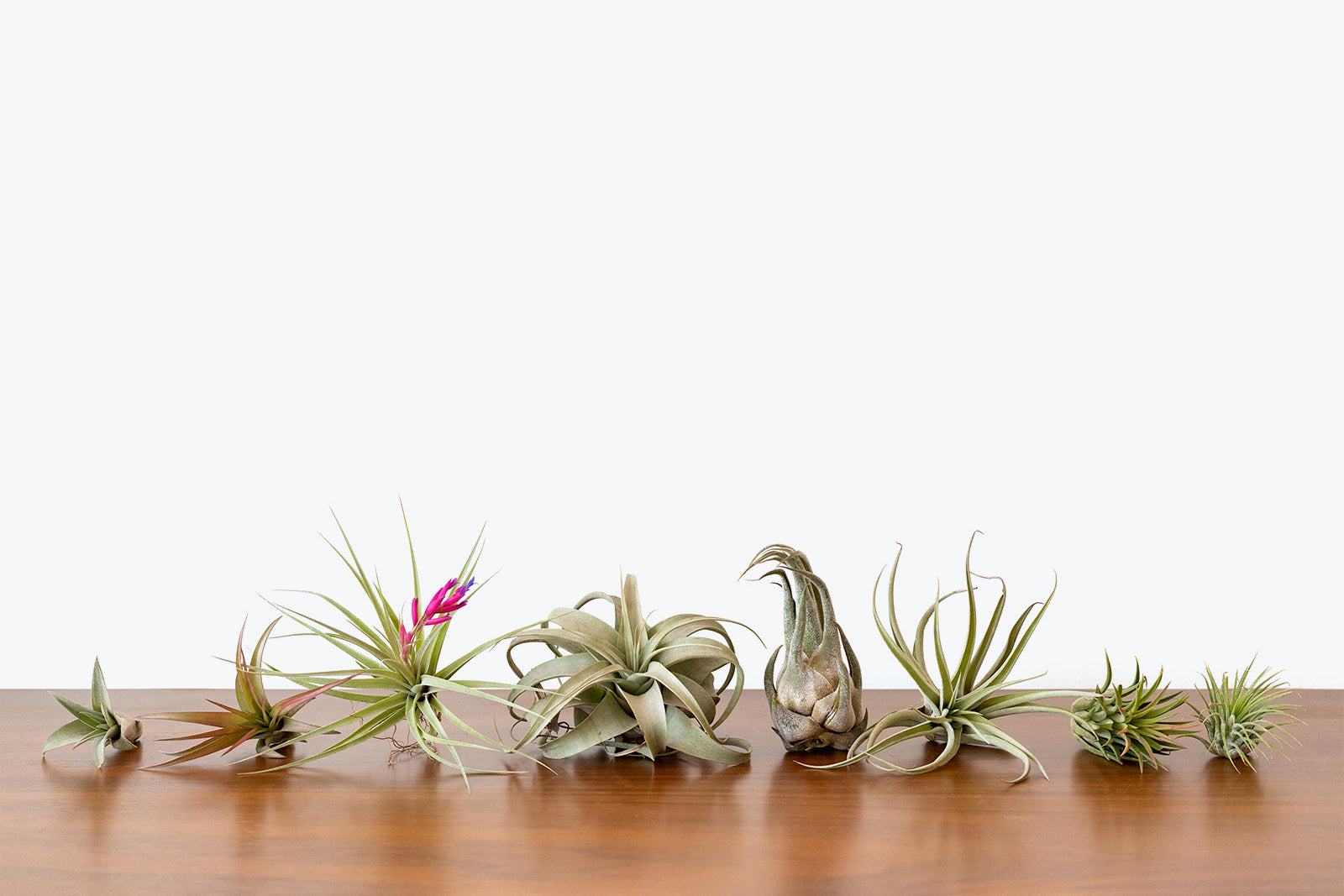
How to Take Care of Your Oxalis
If you love unique houseplants that are also incredibly easy to care for, look no further than the stunning Oxalis genus! Also known as the Shamrock Plant or False Shamrock, these little beauties are very popular around St. Patrick’s Day and it’s pretty clear as to why. The characteristic three, thin, triangular leaflets look very similar to a lucky clover plant, hence their common names. Coming in an assortment of colours and patterns, there will be a variety out there for everyone.
🌸
Unlike most other houseplants, the Oxalis blooms very easily and consistently in the spring and summer months, producing small, trumpet-shaped flowers that last several weeks. These flowers can come in purple, pink, or white but it all depends on the variety.
Native to Brazil and several other countries in southern South America, the Oxalis is part of the wood-sorrel family of Oxalidaceae, which possesses over 550 species. They are all herbaceous plants and typically have divided leaves or leaflets that show something known as sleep movements or nyctinasty, which is the circadian rhythmic nastic movement of higher plants in response to the onset of darkness, or a plant "sleeping". Next time night falls, check out how your Oxalis looks versus how it looked during the day, where the leaves have now closed in the darkness as compared to spreading open during the day!
△ 4" Purple Oxalis
This quirky, prolific grower has beautiful foliage with a mind of its own, constantly growing towards its light source significantly. Each long, slender stem that protrudes from the soil will produce either a leaf or a flower at its tip that will face wherever the light is coming from, which is why we recommend having either a light source that is evenly distributed around the plant, such as windows on all sides or a grow light right above the plant, or rotating your plant weekly to encourage growth on all sides. The leaves have a relatively quick turnover rate, where you may expect to see one or two stems start to brown and droop every week or so, but this is nothing to be concerned about. As soon as you pluck off a dying stem from the base, a new leaf or flower will soon appear keeping your plant full and lush.
☝
Oxalis spread very easily via tuberous rhizomes in their soil, modified subterranean plant stems that send out shoots and delicate roots from their nodes. Long petioles, or stems, will grow from these tubers above the soil to produce the foliage that we see! The tubers also spread very easily, developing new ones as the growing season goes on.
The gorgeous foliage of the Oxalis does not take much work to take care of, as long as your plant is receiving the proper lighting and moisture levels, so why not try out one of these guys in your collection? There are also multiple popular varieties available to you, such as, but not limited to, the following:

Purple Oxalis Triangularis
This is, by far, one of the most sought-after varieties due to its stunning, deep purple foliage. This, combined with the delicate, pale purple flowers that are produced makes a truly delightful combination.

Oxalis Tetraphylla ‘Iron Cross’
With an additional leaf, making it four leaves instead of the classic three, the Iron Cross Oxalis gets its name from the dark purple blotch at the base of each green leaf, giving off the impression of a cross. During the growing season, a spray of light pink flowers will form.

Green Oxalis Triangularis
The green variety is one of the most commonly cultivated varieties as a houseplant and, although it has rather simple foliage, it will produce beautiful white or lavender blooms.
Now that we know more about the Oxalis plant and why it is so gorgeous, let’s get into its care!
Light Requirements
The one thing about Oxalis plants is that they need quite bright light, and a mix of sun and shade at that. They really won’t tolerate lower light levels so we will simply outline exactly what they need to produce plenty of foliage and flowers in your care. Keeping your plant in the correct amount of light will ensure compact growth, rather than super stretched out stems, and plenty of blooms without much maintenance on your part. Remember that plants grow according to how much light they are receiving and an optimal amount of light will encourage the greatest amount of new, healthy growth.
🍃
Try not to be concerned about every yellowing or browning leaf on your plant, as we noted above, they are all a part of the natural process and will happen quite often on an Oxalis. If there are no pests on your plant and it is pushing out healthy growth, your plant will gradually shed its older leaves and flowers over time.
Your plant will need a few hours of direct sunlight and then bright, indirect light for the rest of the day. This will ensure your plant grows well, rather than stunted and stretched out (also known as leggy) when kept in lower light levels. Even though they can survive where there is no direct sunlight, bright light is still necessary if you want your plant to be growing at its peak performance, which we know is everybody's goal with their houseplants. Feel free to check out our Indoor Lighting Guide for more information on light levels in the home and how they affect our plants.
Some examples of prime lighting spots include:
- Keeping your plant directly in South, East, and West-facing windows
- If you don't have any of the above, and only a North-facing window, make sure the plant is kept right on the windowsill with a very large view of the sky outside and no obstructions.
When you first bring your plant home, it may take a little bit for the plant to acclimate to your home and the light levels inside but that is normal. Place your plant on a bright windowsill and it will be very happy in your care! Once an Oxalis has fully adjusted to its new home, it will produce plenty of new leaves and flowers for you to enjoy all spring and summer long. Once one stem dies, a new stem will quickly replace it - the only reason you may notice it is because dead stems become droopy, which is when you pluck them off to make way for new ones.
Watering Requirements
Oxalis are rather low maintenance when it comes to watering as they prefer their soil to go about half to three-quarters dry between waterings. During the winter you will want to keep the soil on the drier side as compared to the warmer months when you will want to let the soil only go about half dry. One thing they will not tolerate is soggy soil (i.e. soil that is constantly moist), as this could lead to rotted tubers and roots in the long run. If you are ever in doubt, feel free to wait a little longer before watering, waiting until the stems start to get a little droopy!
💦
It is important not to let the stems get too droopy as this could lead to a faster turnover of leaves if they don’t receive enough moisture, but know that new foliage will replace it soon enough.
When it comes time to water, make sure to water your plant fully until the soil is evenly moist and there is water coming out of the drainage holes. If the soil is not absorbing the water, try either aerating the soil with a chopstick or bottom-watering, where you let the plant sit in a bowl of 2-3 inches of water for at least 45 minutes until the soil is moist. Remove the plant from the bowl and let any excess water drain out. Wait until the soil is mostly dry before watering again.
🪴
Your plant will not need to be repotted too often and they are actually quite easy to keep in the same pot size for many years if the bulbs are cared for properly.
As for the frequency of watering, that will depend on the light your plant is receiving, the warmth and humidity of your home, the size of the pot, as well as the pot that the plant is planted in. Generally, no two plants will be on the exact same watering frequency, as everyone's home is different! Expect to water more often in the spring/summer months, when the days are longer, warmer, brighter and plants are actively growing, and less often in the winter months when the days are shorter, cooler, darker and when plants are usually dormant. You should also expect to water a plant that is receiving higher light more often than the plant that is receiving lower light.
❓
If you forget to water for an extended period of time and all of the leaves die back, don’t fret! This doesn’t necessarily mean that the plant is dead. In ideal conditions, the bulbs can be revived back with some moisture but try to only do this during the dormant season, which we discuss in the next section.
Propagating your Oxalis is an incredibly easy process and we will outline it for you! If you would like to make a new plant separate from an existing one, all you need to do is dig the tubers out of the soil and separate them if there are multiples attached to each other. Plant them in fresh soil just below the surface, with the root portion aiming downwards and the growing side pointed up. Water them accordingly and place them in bright, indirect light. You should start to see some growth in the next 2-3 weeks as they are rapid growers. Feel free to check out our How to Propagate Through Division Guide for further information.
Dormancy
Most houseplants go through a period of dormancy, or semi-dormancy, in the fall and winter months but this period can be very important for bulbous or tuberous plants, such as the Oxalis. It can actually often be necessary to support the long term health of our plants! Since they are grown via tubers, there are a couple of methods you could follow when it comes time to store away your plant for the winter:
- Oxalis tubers can be collected from the soil they are in during the early fall and stored in a paper bag in a dark, cool place (such as a basement or closet) throughout the cooler months. Then, in the early spring (i.e. March or April), bring the bulbs out and plant them in some fresh soil, placing them in a very bright location and watering appropriately.
☝
Make sure all of the foliage is removed and the bag and bulbs are dry so that they do not rot!
-
On the other hand, you could leave the tuber in the soil and pot that they are in, trim off any growth above the soil level and place the pot in a similar dark, cool spot as above. Then, in the early spring, you can either bring the pot out and place it in a brightly lit spot, watering appropriately, or refresh the soil first before doing this.
-
Alternatively, you could care for your plant as you have been throughout the year and not tuck it away but allow it to go semi-dormant be holding off on watering them and keeping them in a slightly cool location.
💤
Oxalis can be encouraged to go dormant if they get too hot or dry as well, so this is something to keep in mind when you are considering where to place your plant or if you are watering it too infrequently.
No matter which option you choose, the act of storing away your plant for the winter can be beneficial to you as a plant owner because it will alleviate yourself of one more plant to care for. When the warmer months come your plant will bounce back to all its glory in no time! When cared for properly, an Oxalis plant can grace the home for years and years to come, giving you plenty to enjoy in the process.
Humidity
Oxalis are fairly tolerable when it comes to humidity and temperature, so if you're comfortable, your plant is comfortable. That being said, they would much rather prefer a humid environment to a dry one, they are still tropical plants after all! So if you have the time, and want to make the effort, you can:
- Place the nursery pot on top of a bed of pebbles that are just covered in water, this increases the ambient humidity in the air around the plant
- Mist your plant multiple times daily to increase the humidity around your plant
- Purchase a humidifier and keep it in the same area as your plant when turned on
- Group plants that prefer similar humidity levels to increase the ambient humidity in a section of a room.
Remember that just because they are fine with average humidity and temperatures, they still won't enjoy drafts from heating vents, A/C vents, cold window panes, open windows in the winter, or radiators. It would be beneficial to offset the dryness of our homes with higher humidity levels, just think of their natural habitat and try to mimic that.
Fertilizing
For fertilizer, the Oxalis is not too picky and really doesn't need it too often, seeing as they grow quite easily. Fertilize once a month through the Spring and Summer months and then do not fertilize throughout the Winter. Following the directions, use a general-purpose, liquid, balanced houseplant fertilizer that any greenhouse, garden centre, or plant shop offers! Just make sure the soil is damp before fertilizing, otherwise it could burn the roots. Also, never fertilize a plant that is already stressed out (i.e. soaking wet, extremely dry, lost a lot of leaves, etc.), as this will only enhance the stress. Feel free to check out our Fertilizer Guide for more tips and tricks!
Toxicity
All parts of the Oxalis plant contain calcium oxalate crystals so, although the plant looks harmless enough, they can actually cause serious side effects when ingested. These crystals can cause gastrointestinal problems, skin irritation, and even harm to the kidneys when consumed in large amounts. Some symptoms of Oxalis poisoning include drooling, vomiting, diarrhea, and decreased appetite. Since they are toxic to both humans and pets, definitely keep these beautiful houseplants out of reach of inquisitive hands and mouths.
Common Pests & Problems
Oxalis very rarely have any issues or pest infestations because it is very easy to deal with them! Let’s go over the most common issues you may experience:
Pests:
If you spy any webs, bumps or white spots on your plant, it’s possible that it is putting up with some unwelcome visitors, such as spider mites, white fly, or thrips. This problem can quickly become apparent through yellowing leaves or unhealthy growth. Shower your plant with some lukewarm water and remove as many of the adult bugs as you can, then spray your plant with insecticidal soap every 7-10 days, until you are sure they are gone. Please see our Pest Tips & Tricks for further assistance on how to get rid of these pesky insects.
🔑
One bonus feature with Oxalis is that, if the pest infestation is too great, you can always fully trim the plant back, spraying the tubers with insecticide, and then repot them into fresh soil, starting the plant anew.
Spotting:
If it is not because of pests, a couple factors could be at play:
- Sunburn: Although they can handle some full sun, a sudden introduction to very bright light can burn the foliage. But don’t worry, in a few weeks time, any new growth that emerges will have acclimated.
- Powdery mildew: Low light, improper circulation, temperatures issues, and excess humidity can lead to fungal issues such as powdery mildew. Spray all leaves with a solution of baking soda and vinegar (there are plenty of recipes online) and pinch off the affected areas. Make sure your plant is getting lots of bright light and decent air circulation
Mushy stems:
Although relatively easy to care for, one thing they will not tolerate is excess moisture. So, if the soil is staying damp for too long or if the plant is being watered too frequently, this can cause the tubers to rot, therefore leading to mush stems and foliage. Make sure to water your plant as we outline above and to refresh the soil if root rot has occurred!
Drooping stems:
This most often occurs when the plant is not receiving enough light or enough water. Remember that Oxalis love very bright light and should be watered when the soil is about half dry! If any foliage dies back, try not to worry because, as long as the tubers haven’t rotted, new growth should appear in no time.
Final Notes
The Oxalis is a truly fascinating plant because, not only is their foliage exquisite, but they can also recover very easily if anything goes wrong. This is all thanks to the tubers in the soil that store all their nutrients and moisture. All you have to do is make sure their basic care of the proper lighting and watering needs are met! Leave the rest up to your beautiful little houseplant. Check out all the Oxalis options we have to offer and add one to your collection today.







